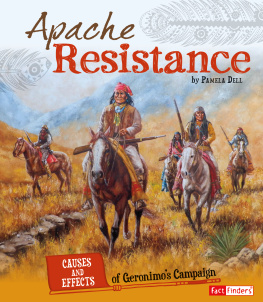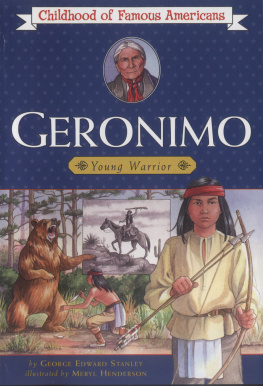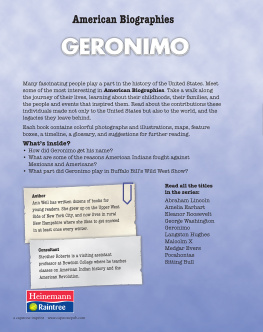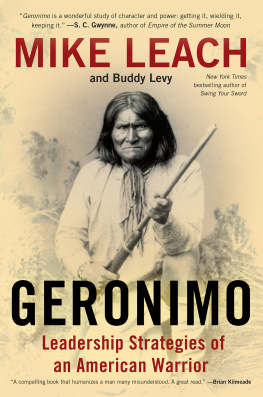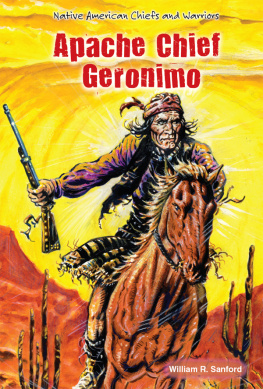IMAGINING
GERONIMO
An Apache Icon in Popular Culture
WILLIAM M. CLEMENTS
2013 by the University of New Mexico Press
All rights reserved. Published 2013
Printed in the United States of America
18 17 16 15 14 13 1 2 3 4 5 6
THE LIBRARY OF CONGRESS HAS CATALOGED THE PRINTED EDITION AS FOLLOWS:
Clements, William M., 1945
Imagining Geronimo : an Apache icon in popular culture / William M. Clements.
p. cm.
Includes bibliographical references and index.
ISBN 978-0-8263-5322-1 (cloth : alk. paper) ISBN 978-0-8263-5323-8 (electronic)
1. Geronimo, 18291909.
2. Apache IndiansKings and rulersBiography.
3. Indians in popular culture.
I. Title.
E99.A6G473 2013
979.00497250092dc23
[B]
2012037469
For Larry D. Ball
colleague, collaborator, friend
Contents
Illustrations
Acknowledgments
MANY PEOPLE DESERVE MY GRATITUDE FOR THEIR HELP IN COMPLETing this project. I begin, though, with an institution, Arkansas State University, where I taught first literature and folklore studies and later cultural anthropology and American Indian studies for forty years. Students, colleagues, and administrators helped to shape the direction my efforts have taken. Particularly, I want to acknowledge the Faculty Leave Committee, which granted me a semester to work on this project at the time when it was finally coming together. Individuals at ASU who deserve notice include Charles R. Carr, who served as chair of the Department of English and Philosophy throughout most of the time I was trying to pin down Geronimos image, and Gloria J. Gibson, who was dean of the College of Humanities and Social Sciences during that same period. Their successorsJerry Ball as chair and Carol OConnor as deanalso deserve acknowledgment. I am especially grateful to two staff members at the Dean B. Ellis Library at ASU: Linda Keller and Michael Sheppard of the Inter-Library Loan Department. No research in the humanities at ASU can go forward without their assistance, and they have located and made available materials that I had feared I would never be able to access.
In addition to these representatives of Arkansas State, I am indebted to Evelyn Clements, Elizabeth Stafford, and Norman Stafford, who accompanied me on some of the travels involved in this undertaking; Mary Donaghy, who assisted in preparing the illustrations; Michael K. Hudson, who alerted me to the drama troupe 1491 and their moving and important articulation of what Geronimo continues to mean for Native North Americans; Southwestern scholar Alan Radbourne, who supplied me with a copy of the watershed film Geronimo! and offered some fine suggestions of other vehicles of the famous Chiricahuas image; and Marty Scarbrough, program director at KASU radio, who identified several musical treatments of Geronimo and copied them onto a CD for me. At the University of New Mexico Press, I am grateful to Elizabeth Ann Albright, the acquisitions editor who encouraged my submission of the manuscript and supported its publication; the anonymous readers who evaluated the manuscript and made suggestions that, even if I did not always follow them, helped me to see where I needed to develop points more completely and fully; copyeditor Sarah Soliz; production editors Amanda Piell and Felicia Cedillos; designer Lila Sanchez; marketing specialists Katherine MacGilvray and Nadya Guerrero-Pezzano; and managing editor Elise McHugh. Of course, none of these individuals should be held responsible for any of this studys shortcomings. They contributed importantly and saved me from many infelicities, but I fear I have persisted, either stubbornly or carelessly, in holding on to interpretations that they may not be comfortable with. I am also grateful to the Louisiana State University Press for allowing quotations from Rawdon Tomlinsons Geronimo after Kas-ki-yeh.
My most significant obligations go to two people. I have known Larry D. Ball, a noted historian of the Southwest of Geronimos time, since 1971. During those forty years, we have been friends and collaborators. And his assistance and advice have been central to this project. He made available to me his vast collection of material on the Southwest, took notice of references to Geronimo for me as he was doing his own research, and talked with me about Geronimo and others who played their roles in the Southwest of the 1870s and 1880s. I hope he will accept the dedication of this book, which does not pretend to the historical rigor that marks his own scholarship. The other person to whom I owe a special debt is Frances M. Malpezzi, with whom I have shared ideas about Geronimo for the past decade and much else for a much longer time. She has read the manuscript several times and been supportive of the project throughout its development.
INTRODUCTION
WHO WAS GERONIMO?
GERONIMO AS THE KING OF SPADES IN A DECK OF NATIVE AMERICAN playing cards; a liquor store in Pensacola, Florida, called Geronimos Spirits; the steel cable on an oil derrick that provides a rapid escape device for a derrickman in case of impending disaster known as the Geronimo line; an Australian company marketing Geronimo Jerky in six flavors, including Spicy Shaman; a Geronimo Heritage Blanket designed by Pendleton ( This situation is not something new. Although journalistically upstaged by a devastating earthquake that struck Charleston, South Carolina, and by the assassination of the king of Bulgaria, Geronimos surrender to General Nelson A. Miles at Skeleton Canyon, Arizona Territory, in September 1886 was noted even in the international press, and for the remainder of his life accounts of his activities as a prisoner of war provided a reliable source of soft news to the newspaper-reading public. He appeared at three worlds fairs and rode in Theodore Roosevelts inauguration parade. His death in February 1909 produced scores of obituaries in newspapers across the United States as well as abroad in the Times of London and other prestigious dailies.

FIG. 0.1. The Geronimo blanket is part of Pendletons Heritage Collection. According to the companys 2004 holiday catalog, A tribute to the famed Apache medicine man, seer and spiritual leader, Geronimo. He was single-minded in his determination to preserve his peoples land and culture through any means necessary. Copyright Pendleton Woolen Mills. Used by permission.
FIG. 0.2. Will Rogers, Ernest Hemingway, and Charles Lindbergh join Geronimo as the honorees whose visages appear on the Century Wall, a project celebrating the beginning of the twenty-first century in Pocahontas, Arkansas. Photograph by William M. Clements


